
Dyce Old Parish Church
There are two pictish stones inside the old Dyce Church reflecting the beginning and the end of Pictish culture, the paganism of the Class 1 stone, with its pictish beast carving and the Christianity of the Class 2 stone with the sign of the cross and pictish carvings.
Class 1 basically means a stone with pictish carvings while class 2 is a stone with pictish and Christian carvings.
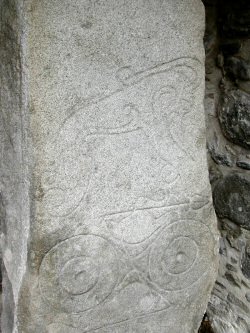 A pistish beast double disc and
z-rod.
A pistish beast double disc and
z-rod.
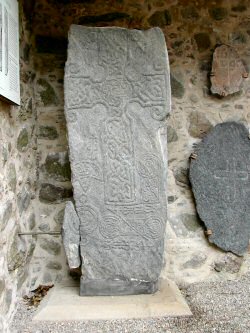 The Class 2 stone has a Christian
cross with a crescent V-rod (mid left), cauldron (lower left), a disc
and rectangle (mid-right) and double disc and Z-rod (lower right.)
The Class 2 stone has a Christian
cross with a crescent V-rod (mid left), cauldron (lower left), a disc
and rectangle (mid-right) and double disc and Z-rod (lower right.)
Ogham, an early form of writing where letters are depicted as strikes along a line is inscribed on the edge of this stone. It goes up one side of the stone, turns 180 degrees and goes back down. The word Rogoddodd can be deciphered, though what the rest means is not clear.
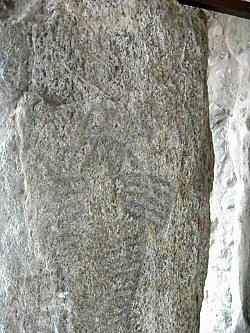
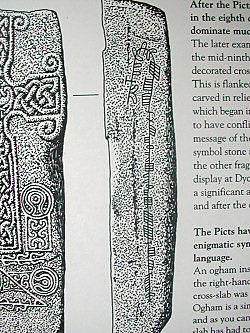
The loop on the Ogham writing. I have taken the liberty of showing part of the interpretation board showing the writing in greater detail.
There are four other early Christian stone on display in the church.
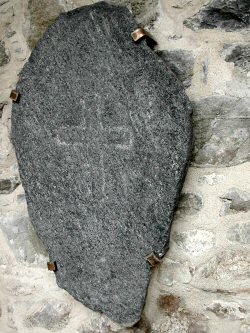 |
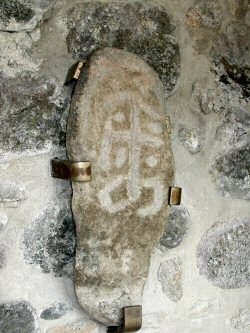 |
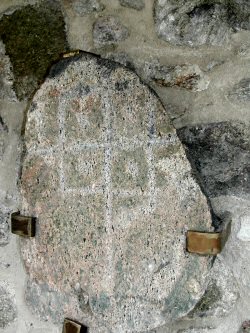 |
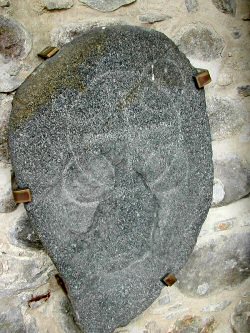 |
RAF Dyce war graves.
Almost a third of all RAF casualties during World War two were attributed to training accidents. RAF Dyce was the site of an Operational Training Unit, which took pilots fresh from flying training and instructed them in the art of flying photo reconnance missions. Also because of its location RAF Dyce had more than a few accidents in the Grampian Mountains to deal with, hence the reason why some of the crew from the Braemar Wellington are buried in Dyce. (Aircraft Memorials.)
The curious thing about the grave below is the lack of any religious symbol below the name. Usually there is something like a Christian cross or a Star of David, etc. denominating the deceased persons religion, in this case there is nothing, which could denote an atheist.
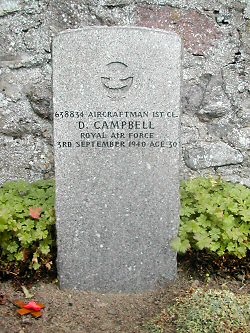 The grave of AC1 Campbell
The grave of AC1 Campbell
Not only had RAF Dyce to manage the burials of the British and Commonwealth servicemen they also buried a number of Germans who were killed around the north-east of Scotland.
In the early days they were buried with full military honours, e.g.. the Heinkel 111 crew at Edinburgh, however I do not suppose they got much of a burial detail as the war dragged on.
Dyce is one of a number of cemeteries around Scotland where German servicemen were buried, a fair number were disinterred after the war and buried in the German War Cemetery at Cannock Chase, in the English Midlands.
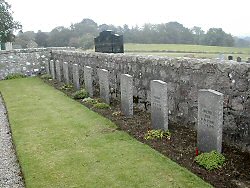 German war dead, Dyce
German war dead, Dyce
Pitmedden Road, near Dyce
On the railway bridge, beside the road that will take you to the old church at Dyce is this pillbox. According to the Defence of Britain Database, this one was for the defence of Aberdeen, although its position close to the River Don and its proximity to Dyce would make it useful for the defence of Dyce airfield as well. The pillbox is clad in clay-bricks which served as the shuttering for the concrete. Looking closely at the photograph you can see the pillbox tilting about five degrees, the power poles beyond are plumb and vertical.
I fired a couple of shots through the gun slits, more or less just for fun and was pleasantly surprised by the results. On one you can see two parallel iron runway beams so the embrasure (gun port) could be covered by an armoured steel panel.
You can also see the brick pillar in the middle of the pillbox which served to support the roof and limit the effects of a ricochets within the pillbox. The other shot of the inside reveals two details, the roof was constructed by pouring concrete onto corrugated iron sheets and the doorway beyond was blocked by pouring concrete into the brickwork with corrugated iron shuttering.
Another shot revealed the embrasure to be blanked off by a metal plate. I was going to scrap this image until I realised that this was one of the original armoured panels in position over the slot.
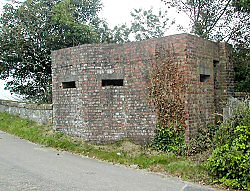 |
Dyce, Pitmedden Road, railway bridge Pillbox |
| The pillbox with the entrance way to the right | |
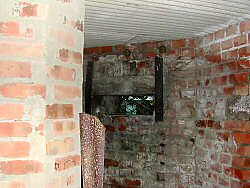 |
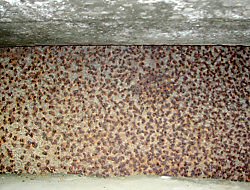 |
| The inside with the window guides | An armoured panel in place over the embrasure |
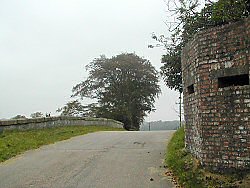 |
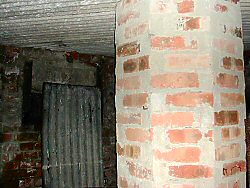 |
| The leaning pillbox of Dyce | Inside with corrugated shuttering on roof & door |